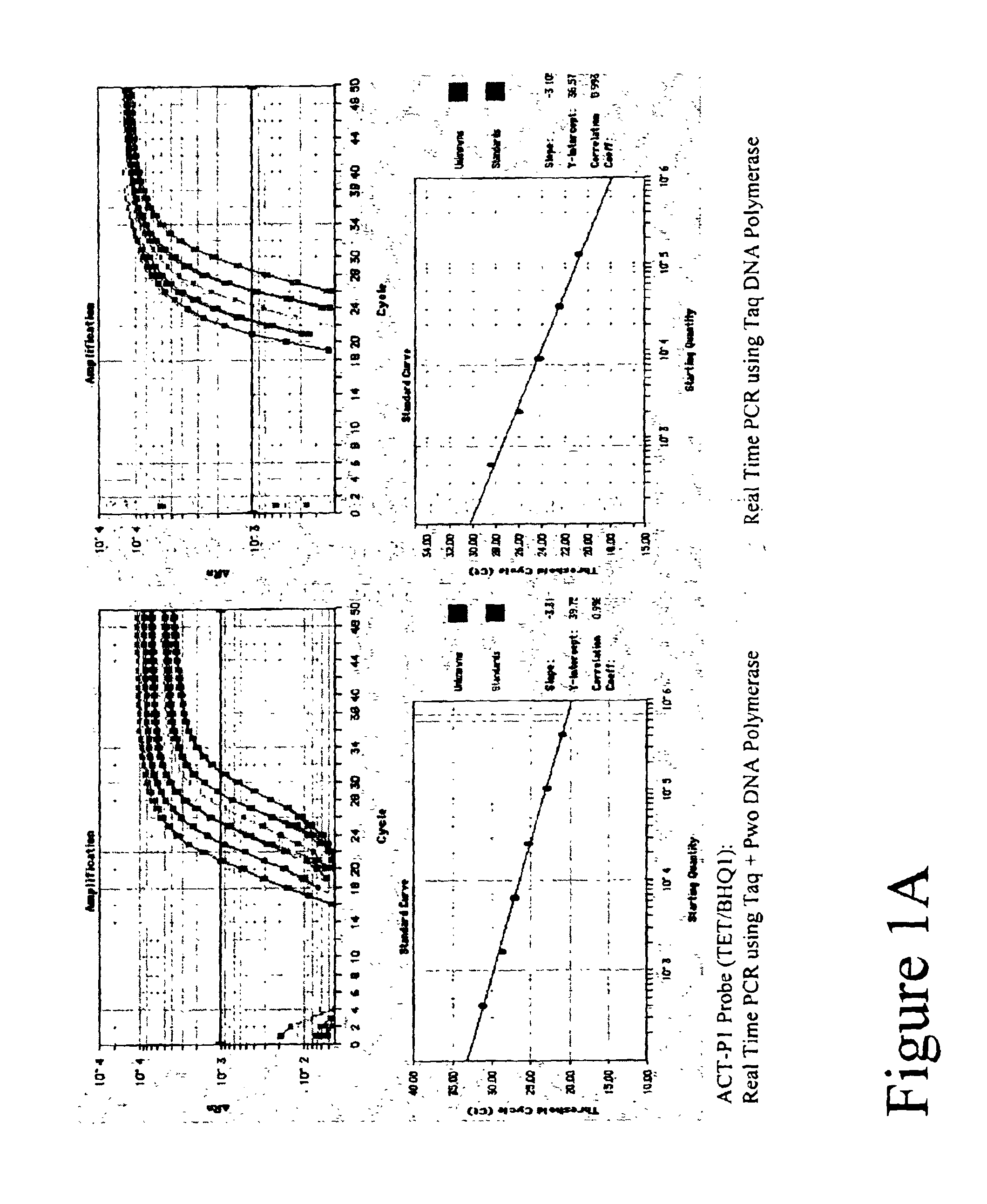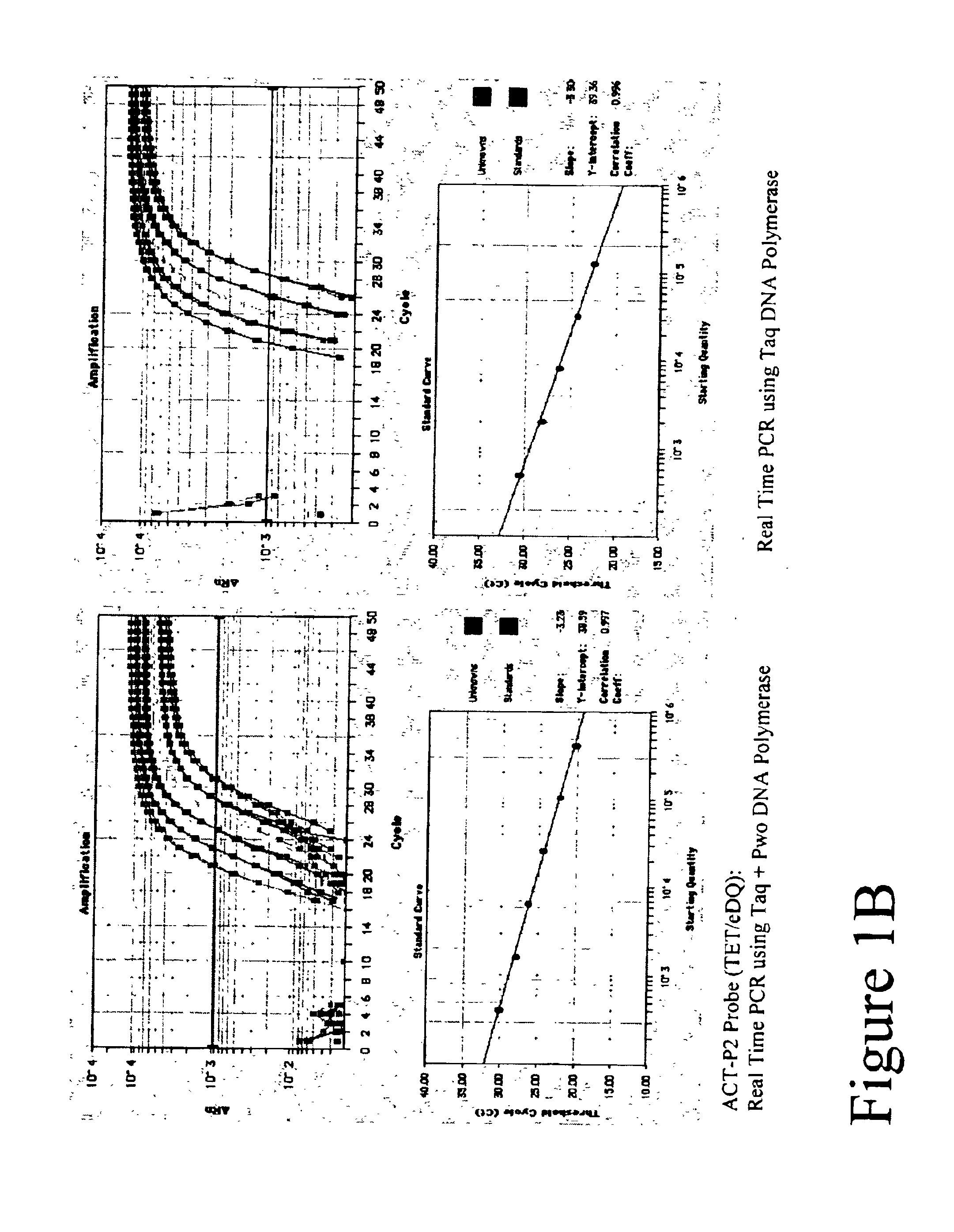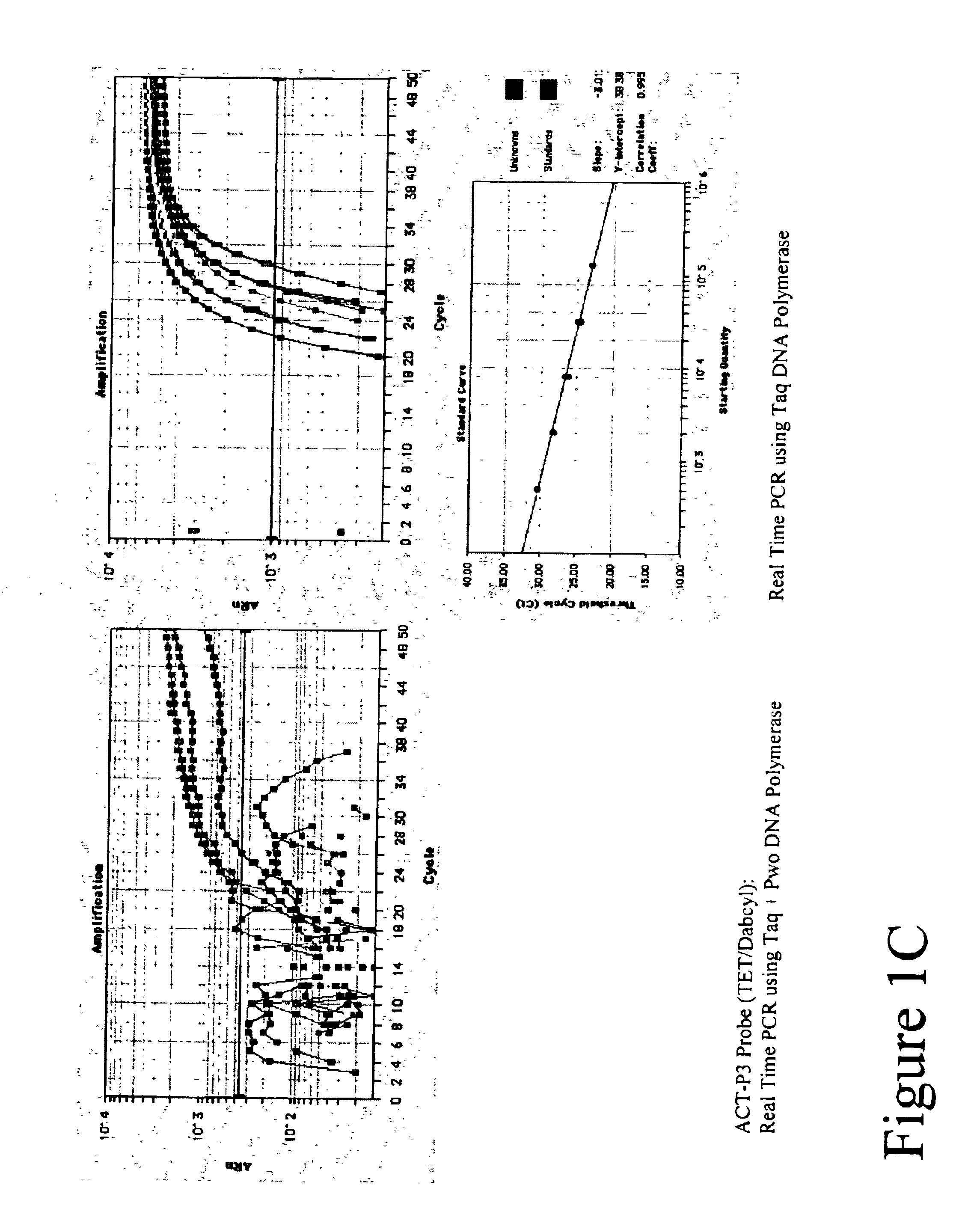Methods of using FET labeled oligonucleotides that include a 3'->5' exonuclease resistant quencher domain and compositions for practicing the same
- Summary
- Abstract
- Description
- Claims
- Application Information
AI Technical Summary
Benefits of technology
Problems solved by technology
Method used
Image
Examples
example 1
Properties and use of TET Labeled FET Probes with Various Quenchers
[0106]Real Time amplifications and detection were performed in ABI PRISM 7700 (Applied Biosystems) using 30 μl reactions that contained 20 mM Tris-HCl (pH 8.3), 60 mM KCl, 5.3 mM MgCl2, 0.2 mM dATP, 0.2 mM dTTP, 0.2 mM dGTP, 0.2 mM dCTP, 0.5 μM of each primer, 0.2 μM FET probe, 4-fold series dilute of Jurkat cDNAs, either 0.6 units Taq Polymerase (Fisher) or a mix of Taq and Pwo DNA Polymerase (Roche Molecular Biochemicals) at unit ratio of 5 to 1.
[0107]A 99 basepair segment of the human beta actin gene was amplified using primers ACT-F1 and ACT-R1 listed in Table 1. Thermal profile was 95° C. 15 sec; 50 cycles of 95° C. 15 sec, 60° C. 30 sec, 72° C. 45 sec. After amplification, fluorescent intensity at each well was measured by post PCR reading.
[0108]Five types of TET labeled FET probes (ACT-P1, ACT-P2, ACT-P3, ACT-P4 and ACT-P5 as shown in Table 1) were tested in Real Time amplification. Post PCR reading result is ...
example 2
Properties and use of FAM Labeled FET Probes with Various Quenchers
[0111]Real Time amplifications and detection were performed in ABI PRISM 7700 using 30 μl reactions that contained 20 mM Tris-HCl (pH 8.3), 60 mM KCl, 5.3 mM MgCl2, 0.2 mM dATP, 0.2 mM dTTP, 0.2 mM dGTP, 0.2 mM dCTP, 0.5 uM of each primers, 0.2 tM FET probe, various copies of a cDNA clone of human bcl-2 gene or Jurkat cDNAs, 0.6 units Taq DNA Polymerase (Fisher Scientific) or a mix of Taq and Pwo DNA Polymerase (Roche Molecular Biochemicals) at unit ratio of 10 to 1.
[0112]A 190 basepair segment of the human bcl-2 gene was amplified using primers BCL-F1 and BCL-R1 listed in Table 1. Thermal profile was 95° C. 15 sec; 50 cycles of 95° C. 15 sec, 60° C. 30 sec, 72° C. 45 sec. After amplification, fluorescent intensity at each well was measured by post PCR reading.
[0113]Five types of FAM-labeled FET probes (BCL-P1, BCL-P2, BCL-P3, BCL-P4 and BCL-P5 as shown in Table 1) were tested in Real Time amplification. Post PCR rea...
example 3
Properties of FET Oligo as Primers
[0116]PCR amplifications were performed in ABI PRISM 7700 using 30 μl reactions that contained 10 mM Tris-HCl (pH 8.85), 25 mM KCl, 5 mM (NH4)2SO4, 5 mM MgCl2, 0.2 mM dATP, 0.2 mM dTTP, 0.2 mM dGTP, 0.2 mM dCTP, 0.5 μM of each primer, 0.2 μM of each primer (ABCG-R1 and ABCG-P1 or ABCG-P2), 1 million copies of template (ABCG-T1) or just TE buffer in no template control (NTC), 0.6 units of Pwo DNA Polymerase (Roche Molecular Biochemicals). Thermal profile was 95° C. 10 sec; 40 cycles of 95° C. 15 sec, 60° C. 60 sec.
[0117]Two types of FET primers (ABCG-P1 and ABCG-P2) and a template (ABCG-T1) as listed in Table 1 were tested in Real Time Amplification of human ABC transporter ABCG2. Multicomponent analysis is shown in FIG. 3. Thus, the subject FET labeled nucleic acid detectors having a BHQ1 at 3′-end are resistant to 3′→5′ exonuclease activity when used as a primer. By contrast, the FET labeled nucleic acid detectors having a TAMRA at 3′-end are degra...
PUM
| Property | Measurement | Unit |
|---|---|---|
| Fraction | aaaaa | aaaaa |
| Fraction | aaaaa | aaaaa |
| Fraction | aaaaa | aaaaa |
Abstract
Description
Claims
Application Information
 Login to View More
Login to View More - R&D
- Intellectual Property
- Life Sciences
- Materials
- Tech Scout
- Unparalleled Data Quality
- Higher Quality Content
- 60% Fewer Hallucinations
Browse by: Latest US Patents, China's latest patents, Technical Efficacy Thesaurus, Application Domain, Technology Topic, Popular Technical Reports.
© 2025 PatSnap. All rights reserved.Legal|Privacy policy|Modern Slavery Act Transparency Statement|Sitemap|About US| Contact US: help@patsnap.com



